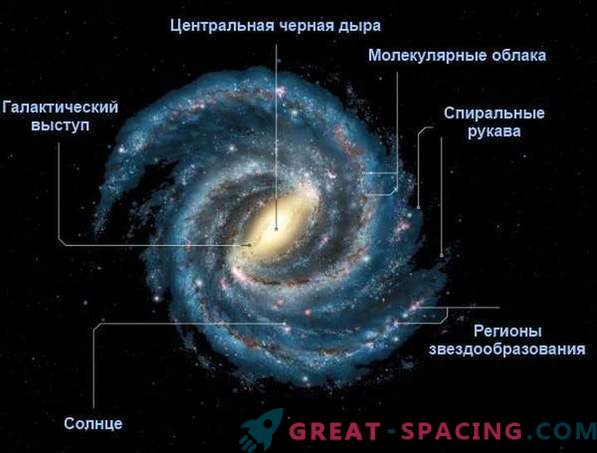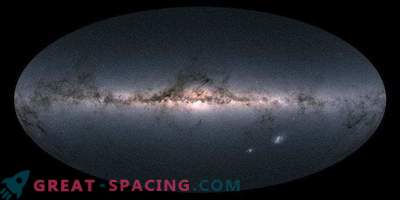
To determine the massiveness of an object, it suffices to use scales. With cosmic bodies everything is much more complicated, as they are located far and rather huge. What will be the massiveness of the native galaxy?
Calculation Difficulties

Structure of the Milky Way: top view
Our magnificent spiral galaxy The Milky Way extends in diameter for 100,000 light-years. All data available to us is obtained through observation and comparison with known physical laws. And its appearance is created on the basis of comparison with other spiral representatives.
Galaxies all the time move, merge and create more massive representatives. They all exist in a relatively close neighborhood, which is observed due to the mass, distance and acceleration. The calculation takes into account the features of rotation of satellite galaxies around ours, as well as the speed of movement of globular clusters around a spiral galactic disk (the more massive the galaxy, the stronger the gravity acts and the increased speed of motion of the clusters).
The main problem is that we are inside the object being measured and are not able to look at the Milky Way from the side. In addition, it is important to take into account not only visible objects, such as stars, planets, asteroids, but also dark matter (it hides the main part of the mass).
Milky Way Mass Estimates

Milky Way and Dark Matter Halo
Previous estimates were constantly changing and were very different, as scientists used different data (various telescopes) and different methods for calculating the distribution of dark matter. Some, for example, used computer models, while others relied on updated information from spacecraft.
Among the earlier information indicated that the mass of the Milky Way reaches 0.96 trillion solar. Other scientists insisted from 700-800 billion to 1-2 trillion. solar masses. The latter more accurate estimate was received recently and offers 1.5 trillion. solar masses.
Where did the comparison with the Sun come from? The fact is that the solar mass is considered a unit of measurement outside our system. It is actively used in astronomical research, when they determine the massiveness of space objects. What helped get the new figure?
Observations of Hubble and Gaia

About the exploits of the space telescope Hubble, which started in 1990, we know from amazing photographs of distant objects. This unit not only observes remote space formations, but also allows you to specify data, like the Hubble constant, which affect the calculations. The telescope was able to determine the speed of movement of clusters that live farther than 65,000 light years. An important contribution was made by the space telescope Gaia, which develops a detailed map of the stars of our galaxy. This apparatus not only indicates the exact coordinates and direction of motion, but also the intrinsic and radial velocities of the stars. He provided speed indicators for clusters in the range of up to 65,000 light years from Earth.
In April 2018 published the second data release, which made it possible to clarify previous calculations. In conjunction with the Hubble figures, it was possible to derive a new figure for the mass of the Milky Way - 1.5 trillion. sunny.
Postscript
Most likely, this is not the final figure. Information is updated all the time, telescopes and calculation methods are getting better, and Gaia will continue to send new information. Knowledge of the exact galactic mass makes it possible to better understand the history of the Milky Way, as well as the place of the galaxy in the universal evolution and hierarchy.











































